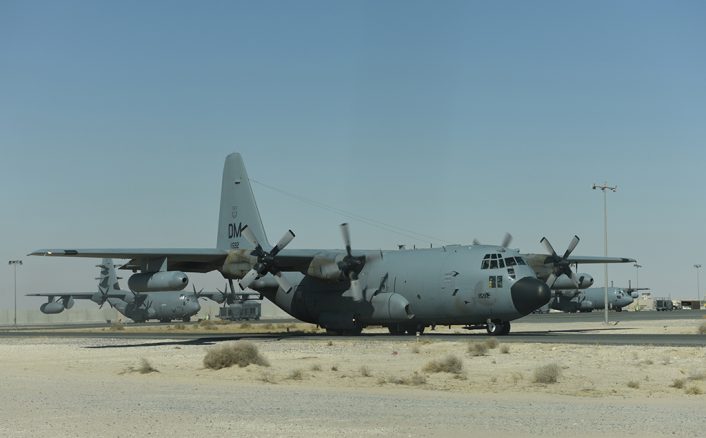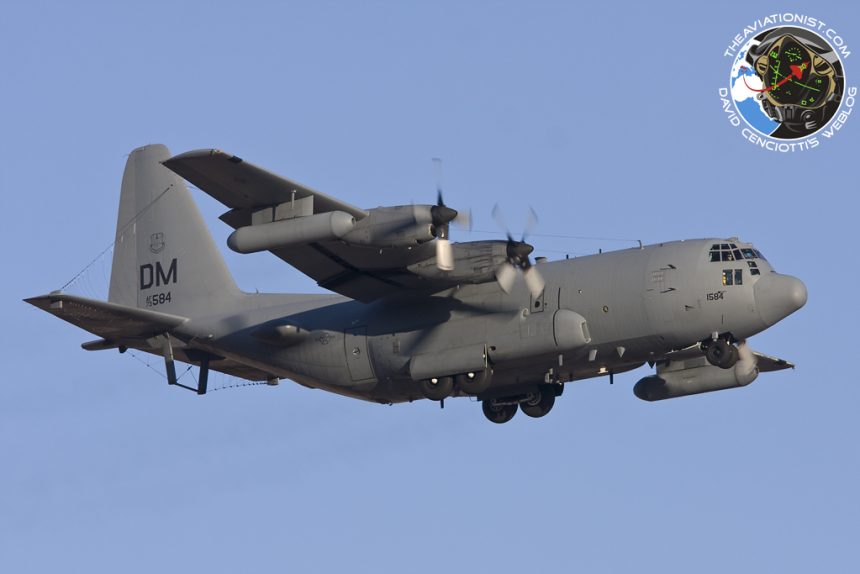One of the few EC-130H Compass Call aircraft, capable to find and hit the enemy forces with denial of service (and possibly cyber) attacks on their communication networks, has been deployed to Osan Air Base, South Korea.
The EC-130H Compass Call is a modified Hercules tasked with various types of signals surveillance, interdiction and disruption. According to the U.S. Air Force official fact sheets: “The Compass Call system employs offensive counter-information and electronic attack (or EA) capabilities in support of U.S. and Coalition tactical air, surface, and special operations forces.”
The USAF EC-130H overall force is quite small, consisting of only 14 aircraft, based at Davis-Monthan AFB (DMAFB), in Tucson, Arizona and belonging to the 55th Electronic Combat Group (ECG) and its two squadrons: the 41st and 43rd Electronic Combat Squadrons (ECS). Also based at DMAFB and serving as the type training unit is the 42nd ECS that operates a lone TC-130H trainer along with some available EC-130Hs made available by the other front-line squadrons.

The role of the Compass Call is to disrupt the enemy’s ability to command and control their forces by finding, prioritizing and targeting the enemy communications. This means that the aircraft is able to detect the signals emitted by the enemy’s communication and control gear and jam them so that the communication is denied. The original mission of the EC-130H was SEAD (Suppression of Enemy Air Defenses): the Compass Call were to jam the enemy’s IADS (Integrated Air Defense Systems) and to prevent interceptors from talking with the radar controllers on the ground (or aboard an Airborne Early Warning aircraft). Throughout the years, the role has evolved, making the aircraft a platform capable of targeting also the signals between UAVs (Unmanned Aerial Vehicles) and their control stations.
According to the official data:
The EC-130H fleet is composed of a mix of Baseline 1 and 2 aircraft. The 55th ECG recently eclipsed 10,900 combat sorties and 66,500 flight hours as they provided U.S. and Coalition forces and Joint Commanders a flexible advantage across the spectrum of conflict. COMPASS CALL’s adaptability is directly attributed to its spiral upgrade acquisition strategy guided by the Big Safari Program office and Air Force Material Command’s 661st Aeronautical Systems Squadron based in Waco, Texas. Combined efforts between these agencies ensure the EC-130H can counter new, emergent communication technology.
The Block 35 Baseline 1 EC-130H provides the Air Force with additional capabilities to jam communication, Early Warning/Acquisition radar and navigation systems through higher effective radiated power, extended frequency range and insertion of digital signal processing versus earlier EC-130Hs. Baseline 1 aircraft have the flexibility to keep pace with adversary use of emerging technology. It is highly reconfigurable and permits incorporation of clip-ins with less crew impact. It promotes enhanced crew proficiency, maintenance and sustainment with a common fleet configuration, new operator interface, increased reliability and better fault detection.
Baseline 2 has a number of upgrades to ease operator workload and improve effectiveness. Clip-in capabilities are now integrated into the operating system and, utilizing automated resource management, are able to be employed seamlessly with legacy capabilities. Improved external communications allow Compass Call crews to maintain situational awareness and connectivity in dynamic operational and tactical environments.
Delivery of Baseline-2 provides the DoD with the equivalent of a “fifth generation electronic attack capability.” A majority of the improvements found in the EC-130H Compass Call Baseline-2 are classified modifications to the mission system that enhance precision and increase attack capacity. Additionally, the system was re-designed to expand the “plug-and-play” quick reaction capability aspect, which has historically allowed the program to counter unique “one-off” high profile threats. Aircraft communication capabilities are improved with expansion of satellite communications connectivity compatible with emerging DoD architectures, increased multi-asset coordination nets and upgraded data-link terminals. Furthermore, modifications to the airframe in Baseline-2 provide improved aircraft performance and survivability.
Although it’s not clear whether this ability has already been translated into an operational capability, in 2015, a USAF EC-130H Compass Call aircraft has also been involved in demos where it attacked networks from the air: a kind of in-flight hacking capability that could be particularly useful to conduct cyberwarfare missions where the Electronic Attack aircraft injects malware by air-gapping closed networks.
With about one-third of the fleet operating in support of Operation Inherent Resolve (indeed, four EC-130Hs, teaming up with the RC-135 Rivet Joint and other EA assets, are operating over Iraq and Syria to deny the Islamic State the ability to communicate), the fact that a single EC-130H (73-1590 “Axis 43”) was recently deployed from Davis Monthan AFB to Osan Air Base, South Korea, where it arrived via Yokota, on Jan. 4, 2018, it’s pretty intriguing.
Airborne from Yokota AB, Japan routing to Osan AB, South Korea
🇺🇸 US Air Force
EC-130H Compass Call
73-1590 AXIS43 https://t.co/vlZq5M7FZH
— Aircraft Spots (@AircraftSpots) January 14, 2018
Obviously, we can’t speculate about the reason behind the deployment of the Electronic Warfare with alleged Cyber-Attack capabilities (that could be particularly useful against certain threats these days….) aircraft south of the DMZ: however, the presence of such a specialized and somehow rare aircraft in the Korean peninsula, that joins several other intelligence gathering aircraft operating over South Korea amid raising tensions for quite some time, is at least worth of note.
Update: some of our sources have suggested that the aircraft was deployed to perform anti-IED (Improvised Electronic Device) tasks during the Winter Olympics, kicking off on Feb. 9, 2018 in PyeongChang County, South Korea.









